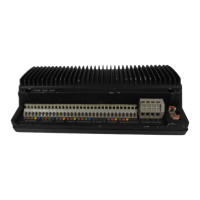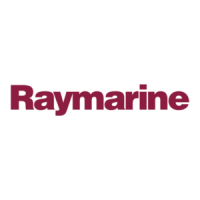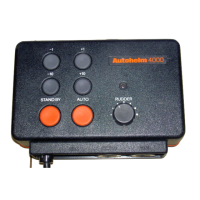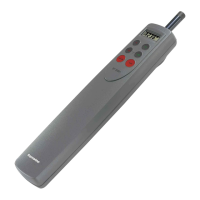Do you have a question about the Raymarine Autohelm 6000 and is the answer not in the manual?
Describes the various control units and interfaces for the autopilot system, including course computer, control units, and compass.
Details the different types of drive units (rotary, linear, hydraulic) for the autopilot, including their specifications and applications.
Provides a brief overview of the complete autopilot system components and their interconnections.
Details the mounting and connection of the course computer unit, emphasizing protected and ventilated positioning.
Explains the installation of indicating and non-indicating control units, including hand-held units and deck sockets.
Covers the correct positioning and mounting of the fluxgate compass to minimize magnetic deviation and ensure accuracy.
Instructions for mounting and connecting the windvane sensor, including cable routing and gland fitting.
Describes the installation of the auxiliary alarm unit, including hole boring and watertight joint creation.
Details the installation of the radio navigation interface unit near the navigation receiver.
Installation guidance for the rotary drive unit, including chain reduction ratios and mounting considerations.
Installation of the linear drive unit, focusing on tiller arm connection, alignment, and mounting structure integrity.
Installation of the hydraulic drive unit, emphasizing placement, sealing, and connection of hydraulic lines.
Details the interconnection of peripheral units via the connector unit, including cable types and color coding.
Explains DC power supply connections, polarity, fuses, and circuit breaker requirements for the system.
Explains the fundamental operating principles of the Autohelm 6000 system, including course monitoring and rudder correction.
Describes the basic functions of fixed control units and their buttons for engaging auto, stand-by, and altering course.
Explains the basic control functions of the hand-held remote unit for power steering and autopilot control.
Outlines the control functions specific to the windvane system mode, including engaging windvane and automatic tacking.
Explains how operating modes are indicated via LED or display prefix and the functions of the course display.
Describes the setup and function of the off-course alarm system, including deviation limits and silencing.
Details the operation of the autopilot when supervised by a navigation interface, focusing on cross-track error.
Covers initial setup procedures, including switching on, gain setting, fluxgate alignment, and windvane setting.
Describes functional tests for controls, modes, automatic trimming, and verifies correct operation of the system.
Explains how to check and correct compass deviation for accurate navigation and course setting.
Outlines mechanical checks for drive units, steering system integrity, and current limit cutout functionality.
Provides an initial procedure for conducting sea trials of the autopilot, including course changes and manual steering practice.
Details how to adjust rudder control settings for optimal steering performance based on vessel type and conditions.
Lists checks and troubleshooting steps for poor steering performance, including installation, deviation, and wiring checks.
Addresses the specific issue of the pilot failing to disengage from Auto to Stand-by and provides corrective actions.
Lists key areas for regular inspection of the autopilot installation, including drive chain, lost motion, and cable connections.
Guides the user through a flowchart to locate potential faults in the system by checking control units and course computer.
Details the terms, conditions, and claim process for both limited and full international product warranty.
Describes the various control units and interfaces for the autopilot system, including course computer, control units, and compass.
Details the different types of drive units (rotary, linear, hydraulic) for the autopilot, including their specifications and applications.
Provides a brief overview of the complete autopilot system components and their interconnections.
Details the mounting and connection of the course computer unit, emphasizing protected and ventilated positioning.
Explains the installation of indicating and non-indicating control units, including hand-held units and deck sockets.
Covers the correct positioning and mounting of the fluxgate compass to minimize magnetic deviation and ensure accuracy.
Instructions for mounting and connecting the windvane sensor, including cable routing and gland fitting.
Describes the installation of the auxiliary alarm unit, including hole boring and watertight joint creation.
Details the installation of the radio navigation interface unit near the navigation receiver.
Installation guidance for the rotary drive unit, including chain reduction ratios and mounting considerations.
Installation of the linear drive unit, focusing on tiller arm connection, alignment, and mounting structure integrity.
Installation of the hydraulic drive unit, emphasizing placement, sealing, and connection of hydraulic lines.
Details the interconnection of peripheral units via the connector unit, including cable types and color coding.
Explains DC power supply connections, polarity, fuses, and circuit breaker requirements for the system.
Explains the fundamental operating principles of the Autohelm 6000 system, including course monitoring and rudder correction.
Describes the basic functions of fixed control units and their buttons for engaging auto, stand-by, and altering course.
Explains the basic control functions of the hand-held remote unit for power steering and autopilot control.
Outlines the control functions specific to the windvane system mode, including engaging windvane and automatic tacking.
Explains how operating modes are indicated via LED or display prefix and the functions of the course display.
Describes the setup and function of the off-course alarm system, including deviation limits and silencing.
Details the operation of the autopilot when supervised by a navigation interface, focusing on cross-track error.
Covers initial setup procedures, including switching on, gain setting, fluxgate alignment, and windvane setting.
Describes functional tests for controls, modes, automatic trimming, and verifies correct operation of the system.
Explains how to check and correct compass deviation for accurate navigation and course setting.
Outlines mechanical checks for drive units, steering system integrity, and current limit cutout functionality.
Provides an initial procedure for conducting sea trials of the autopilot, including course changes and manual steering practice.
Details how to adjust rudder control settings for optimal steering performance based on vessel type and conditions.
Lists checks and troubleshooting steps for poor steering performance, including installation, deviation, and wiring checks.
Addresses the specific issue of the pilot failing to disengage from Auto to Stand-by and provides corrective actions.
Lists key areas for regular inspection of the autopilot installation, including drive chain, lost motion, and cable connections.
Guides the user through a flowchart to locate potential faults in the system by checking control units and course computer.
Details the terms, conditions, and claim process for both limited and full international product warranty.
| Type | Autopilot System |
|---|---|
| Model | Autohelm 6000 |
| Manufacturer | Raymarine |
| Power Supply | 12V DC |
| Control Method | Electronic |
| Display Type | LCD |
| Compass | Fluxgate |
| Rudder Feedback | Yes |
| Interface | NMEA 0183 |
| Max Boat Length | 12m |











